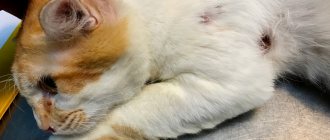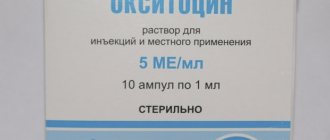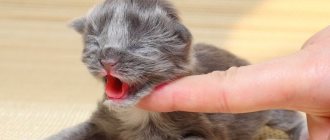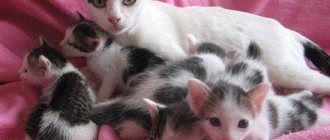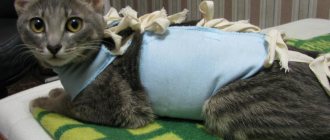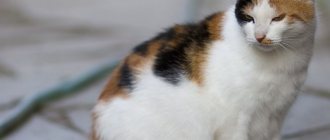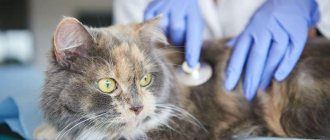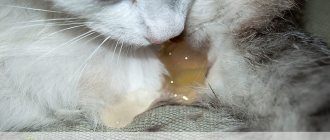The joyful moment for the owners has come - the birth of kittens, but this is always fraught with many questions and dangers. Particular attention should be paid to such a moment of recovery as discharge in a cat after childbirth. Any owner, even one without veterinary education, should be able to distinguish a normal postpartum condition from a pathological one, which requires immediate intervention from a specialist. In this article we will talk about how to find differences in a cat’s condition and what the animal’s hygiene should be.
Anxiety after childbirth: possible causes
The owner needs to pay attention on the first day after the birth of the kittens.
If the birth went well, then the animal calmly settles down and begins to feed the offspring.
Refusal to eat on the first day and short absences to drink water are considered the norm - the cat is afraid to leave newborn babies unattended for a long time.
If your pet shows anxiety, there are several reasons:
- psychological;
- incomplete childbirth or the placenta did not come out;
- postpartum complications.
The owner needs to pay attention on the first day after the birth of the kittens in order to help the pet in a timely manner.
When the problem is psychological
The process of giving birth to kittens is stressful for a cat and changes its behavior.
The cause of concern may be:
- Confusion. This occurs in young animals. An inexperienced cat does not always lie down correctly, preventing newborns from reaching the nipple.
- Late or insufficient lactation. In some cats, milk production does not begin immediately or lactation is not sufficient to feed the offspring.
In both cases, the babies squeak in displeasure, causing concern to the mother. The cat, with its meowing, asks for help from its owner.
If the reason is that the babies cannot reach the nipples, then you should help the pet and attach the kittens to the mammary glands. Once the newborns begin to nurse, the cat will calm down.
If there is not enough milk, you need to dilute the milk mixture and feed the babies with a pipette. Well-fed kittens will fall asleep and the animal will calm down.
Incomplete labor and symptoms of eclampsia
If the animal was calmly feeding the babies and suddenly became worried, then the reason may be the birth of another kitten.
With unplanned matings, conception can occur during the entire estrus, and the birth of the next baby can occur in a few hours. Sometimes this period extends for several days.
It is dangerous when an afterbirth or an unborn fetus remains in the uterus.
Be sure to read:
A pregnant cat has bleeding: normal or pathological, what to do when you need help
Signs of pathology:
- the appearance of dark vaginal discharge;
- fever;
- general weakness;
- apathy.
Difficulty in passing the placenta is associated with weakening of labor. To provide quick help to your pet if a condition arises, it is recommended to purchase the drug Oxytocin in advance.
To stimulate contraction of the reproductive organ, 0.2 or 0.3 ml is placed at the withers. In order not to harm the animal, it is recommended to check the amount of first aid medication with your veterinarian in advance.
Another dangerous condition that can develop during the birth of offspring is eclampsia (sharp redistribution of calcium in the body).
Calcium from the blood enters milk in large quantities, and this causes the development of the following symptoms:
- dyspnea;
- temperature increase;
- trembling and convulsions;
- lack of coordination.
The pet is rushing around, trying to hide in a corner. In some cases, it is possible to eat the born cubs. If treatment is not carried out, the condition worsens, apathy and drooling appear. The animal must be urgently taken to the veterinarian.
Normal and abnormal bleeding after childbirth - how to distinguish?
An inflammatory process in a cat's reproductive organ develops when an infection enters the uterus.
Normally, after birth, a small amount of blood is released.
Signs of normal bleeding:
- on the first day, pink or reddish-brown mucus comes out of the vagina;
- on the second day the discharge becomes almost invisible.
The release of vaginal discharge stops by the end of the second week.
If scarlet or dark blood flows out of the vagina in a stream or in small portions, and the animal becomes lethargic and is breathing heavily, this indicates postpartum hemorrhage. The condition is dangerous and without urgent veterinary care the pet will die.
Inflammation of the uterus: signs
An inflammatory process in a cat’s reproductive organ develops when an infection enters the uterus.
Symptoms of inflammation:
- lethargy;
- refusal of food;
- hyperthermia;
- thick reddish-green discharge from the birth canal;
- refusal to care for children;
- apathy;
- desire to hide in a far corner.
If you suspect inflammation, you should call a veterinarian at home or take the animal to a veterinary clinic.
Diseases accompanied by discharge
In the early postpartum period, you need to carefully monitor the condition of your pet in order to notice in time the development of the following diseases:
- Metritis. Inflammation of the uterine wall is provoked by insufficient hygiene in the nest, delayed separation of the placenta, or a dead and undelivered fetus. A greenish viscous mass is released from the vulva.
- Mastitis. Due to stagnation of milk, breast tissue becomes inflamed. Local hyperthermia and purulent discharge from the nipple appear.
Be sure to read:
Pregnancy of a Scottish Fold cat: how long they walk, behavior, what to feed, childbirth
In the first days, the owner needs to examine the nipples and monitor the nature of the vaginal discharge in order to notice pathological abnormalities in time.
Treatment
To prescribe the necessary treatment, the veterinarian conducts an examination using palpation, ultrasound, and x-rays and consists of the following:
- For minor bleeding caused by Oxytocin, veterinarians prescribe hemostatic agents; if significant blood loss is observed, then surgical intervention will have to be performed on the animal.
- If a cat gets sick, her temperature rises, then the kittens need to be isolated from their mother and transferred to artificial feeding.
- When a veterinarian prescribes gentle treatment, the owner may not have to face the question of separating the mother from the kittens.
- If a cat is diagnosed with inflammation of the uterus, then in addition to antibiotic therapy, the veterinarian prescribes medications that lead to an increase in tone. As a result, the remaining tissue is removed from the uterus. In addition to medications, you can massage your tummy. With timely treatment, a complete cure occurs in your pet after 2 weeks.
- Immunostimulants and vitamins will help the animal recover after a difficult period.
- In case of inflammatory processes in a cat, it is necessary to conduct a milk test. If it turns out to be infected, the kittens must be separated from their mother.
If your cat has bloody discharge, the situation needs to be assessed immediately. If complications occur, you should contact your veterinarian for medical help as soon as possible. It is very important that assistance is provided in a timely manner, because the life of a young mother depends on it.
Complications during childbirth
In the first days, the owner needs to examine the nipples and monitor the nature of the vaginal discharge in order to notice pathological abnormalities in time.
Some animals calmly give birth in the presence of the owner, while others try to hide in a secluded corner. If the pet is hiding, then it cannot be left unattended.
Your cat may need help with the following conditions:
- Weak labor. This happens due to a large fetus or weakness of the uterine muscles.
- Bleeding. Appear when the birth canal or uterine walls are damaged. Veterinarian assistance should be provided within 10 minutes.
- The birth of a kitten in the amniotic sac. Usually the bladder ruptures inside the uterus, but if it comes out intact, then you need to break the membrane and give the baby to the mother. If this is not done, the kitten may die.
You need to observe the animal unobtrusively, trying not to disturb it. If the cat trusts the owner, then she herself asks for help with a loud meow.
Discharge in a pregnant cat
Pregnancy lasts 9 weeks and consists of the following periods:
- From 0 to 3 weeks, the embryo is fertilized and attaches to the wall of the uterus.
- From 4 to 6 weeks, the uterus increases in size, the embryos grow, and are determined by palpation.
- From 7 to 9 weeks, the embryos are fully formed, and the female prepares for childbirth.
The 2nd and 3rd periods are the most dangerous, the cat sheds the fetus prematurely or contractions begin, the kittens are born premature.
Brown discharge at any time alerts doctors; darkening is a sign of placental abruption and fetal death in the womb. A dangerous situation for the body occurs during intoxication, so that the woman in labor does not die, doctors provide assistance to her.
Late treatment results in the death of the pregnant female and kittens.
Adviсe:
- Pregnancy is planned according to the rules after consultation with a veterinarian, all vaccinations are given, and vitamins are taken.
- The animal is kept away from drafts and sudden changes in temperature are prevented.
- The owners treat the cat carefully and do not touch the abdominal area.
- Attention is paid to all deviations from the norm.
- The pet's condition is always monitored.
Danger signs:
- Scarlet blood indicates tissue damage; if it flows for about 10 minutes, you need to seek help from a surgeon to stop the bleeding.
- Placental abruption occurs in the 2nd stage of pregnancy.
- Green mucus with a disgusting odor comes out after the embryo dies. The body of the expectant mother is exposed to toxins, works poorly, kidneys, liver and other systems fail.
- Impurities of pus indicate inflammation, an examination is carried out by a veterinarian, therapy is prescribed to save the pet’s life, and antibiotics are used. Termination of pregnancy is performed in the most difficult situations.
Bloody discharge before birth in a pregnant cat appears after rupture of the uterus or other internal organs. Comprehensive tests and ultrasound examination are carried out in case of detachment, the cat is observed by a doctor before the onset of labor.
The veterinarian looks for dead fetuses in the abdomen and performs a cesarean section or premature birth if found. The cat's health cannot be saved without surgery if the kitten dies in the womb.
Diarrhea is often confused with discharge from the loop; digestive problems are resolved with the participation of a veterinarian, since they affect the development of the embryos. Amniotic fluid and other secretions are examined after birth, the veterinarian studies their properties and prescribes medications.
A set of measures to prevent undesirable consequences of childbirth
When preparing for childbirth, even experienced animals experience fear and anxiety. The nervousness of the cat's mother can negatively affect the birth process.
You need to observe the animal unobtrusively, trying not to disturb
To reduce the likelihood of complications, it is necessary to prepare in advance for your pet a place that meets the following requirements:
- Accessibility for cleaning. You need to be able to clean the cat’s “nest” and at the same time disturb the mother and offspring as little as possible. A good option would be a mattress covered with an absorbent diaper.
- Space limitation. While crawling, newborns can fall off the bedding, and the kitten’s squeak unnerves the pet. If labor is not completed, the reaction to the baby's crying can cause complications. A large box or installation of limiting sides will do.
- No drafts. The immunity of both mother and cubs is still weak.
- Removing strangers. Extra people make the animal worry and try to hide the born offspring. Inexperienced cats can accidentally crush babies. In a calm environment, the pet will relax, give birth and settle down so that it is more convenient for newborns to suckle.
Be sure to read:
Can a cat give birth to one kitten if the fetus is in the birth canal, what to do?
A cat giving birth should have a bowl and a toilet next to the “nest”. The birth process can take several days and the cat's mother needs to ensure that her natural needs are met.
Diagnosis
As with symptoms, diagnosing bleeding may seem straightforward. But at the same time, you need to understand that it is important for the veterinarian to see not the cat’s blood after birth, but the reason that caused the hemorrhage.
For this, the following diagnostic techniques are used:
- First you need to find out exactly how much blood the animal is losing. Most often this is quite simple to do. Medical sponges are placed in the cat's vagina, the weight of which is precisely known. After a certain time, the absorbent material is removed and weighed. Since a milliliter of blood weighs about a gram, conclusions about the rate of blood loss are easy to draw.
- Determining heart rate and measuring blood pressure.
- Hematocrit (count of red blood cells).
- Study of blood coagulation factors.
Therapeutic techniques
The goal of treating postpartum hemorrhage is to find and treat the cause of the hemorrhage as quickly as possible . There is simply no time for long thoughts. As a rule, the following methods are used:
- Removing parts of the placenta remaining in the uterus.
- At the same time, the condition of the vaginal tissue and the uterus itself is examined.
- To relieve hemorrhage in the lumen of the organ, a Foley catheter is inserted there. In cases where it simply is not available, medical sponges and other materials with high absorbency are used.
- Laparotomy. In severe cases, when you need to act quickly, specialists cut open the abdomen and examine the organs from the outside.
- Hysterectomy. Surgical removal of the uterus.
Tracking signs of pathologies
In order to prevent serious complications for the cat’s health, the owner should pay attention to the following when examining his pet:
- Nipples. Hardening and redness of the mammary gland is the first sign of mastitis.
- Discharge from the vulva. Bleeding or large amounts of mucus indicate pathology.
- Shortness of breath, convulsions and loss of coordination. Indicates eclampsia. The cat needs calcium supplements.
Observations should be made from the moment the kittens begin to eat on their own. Until this time, you need to feed your pet with phosphorus, fish oil, calcium and provide adequate nutrition.
Prevention measures
Preventative measures will help prevent complications after childbirth:
- Do an ultrasound of the uterus of a pregnant cat to know the exact number of kittens and not worry that one of them remains in the womb or birth canal.
- Conduct an examination of the cat for the presence of pathologies, the exacerbation of which during pregnancy or during childbirth can threaten the health and life of the animal. If you have urolithiasis after childbirth, bloody mucus may appear in the urine, and during pushing, stones and sand may become dislodged. There is a high probability of damage to the genitourinary system. You will need to take a urine test and undergo an ultrasound of the kidneys and genitourinary system in order for the veterinarian to prescribe treatment.
- Properly care for your pregnant and postpartum cat. Provide her with peace, the help she needs, a balanced diet and enough fluids.
- Carefully monitor the condition of the body and behavior of your pet. Cover the box in which the mother and her offspring live with a white cloth to monitor the color and intensity of postpartum discharge.
What should the owner do?
The owner of the animal should remember a few simple rules:
- Don't interfere. Childbirth is a natural process, and most cats give birth on their own. You just need to unobtrusively observe the pet’s behavior.
- Do not panic. The owner's anxiety will increase the cat's anxiety.
- Be ready to help. It is recommended to consult with a veterinarian in advance about what medications may be required (hemostatic agents, labor inducers, etc.).
Recovery in the postpartum period
Breastfeeding an infant
Every woman in the postpartum period should know that breastfeeding is an excellent prevention of all kinds of complications. After all, when a baby is applied to the breast, there is an immediate release of the hormone oxytocin, which also causes contractions of the uterus. After feeding, a woman may observe a visible increase in discharge, which is associated precisely with contraction of the muscles of the uterus and should not cause concern.
To speed up uterine contractions, you should empty your bladder in a timely manner. During the postpartum period, it is advisable to do this every three hours, even if the woman does not have a pronounced feeling of bladder fullness, and to avoid constipation.
For 1-2 months after giving birth, discharge cannot be absorbed with tampons, precisely because they do not remove lochia, but simply absorb them. This can lead to the proliferation of pathogenic bacteria and microorganisms. It is recommended to use pads or diapers instead of tampons. Choose unscented products, as you need to control not only the color and number of lochia, but also their smell.
It is extremely important to maintain good personal hygiene. You should especially carefully monitor the hygiene of the genital organs one to two weeks after childbirth, when the discharge is still bloody. During this time, it is forbidden to take a bath, limiting yourself to showering only. The stream of water from the shower should not be very strong and should be directed from front to back - and only from the outside. To safely clean the external genitalia and vaginal mucosa, it is recommended to use special products - for example, washing gels for intimate hygiene Ginocomfort. These products were developed by specialists from the pharmaceutical company VERTEX, are characterized by a safe composition, including natural active ingredients, and also have all the necessary certificates, certificates and other necessary documents.
Sexual rest continues up to 42 days, and intimate relationships are resumed only after a control ultrasound of the pelvic organs, examination by an obstetrician-gynecologist and an adequate selection of a contraceptive method.
Exercising after childbirth
Sources:
- EARLY DIAGNOSIS AND PREVENTION OF SUBINVOLUTION OF THE POSTPARTUM UTERUS. Naumkin N.N., Ivanyan A.N., Smirnova T.I. // Bulletin of new medical technologies. – 2008. – No. 2. – pp. 46-48.
- CYTOLOGY OF UTERINE LOCIA IN ENDOMETRITIS AFTER BIRTH. Kupert M.A., Kupert A.F., Solodun P.V. // Acta Biomedica Scientifica. – 2004. – No. 2. – pp. 172-175.
- Cystic fibrosis: modern achievements and current problems. Kapranov N.I. and others // M., 2005.
- The importance of cytological examination of lochia in assessing the condition of the uterus in the postpartum period. Z.K. Fursova. A.P. Nikonov, N.A. Lutfulaeva, E.A. Kuchuchurova // Obstetrics and gynecology. - 1991. - No. 1. pp. 45-49.
- Postoperative purulent-septic complications in obstetrics (prediction, prevention, early diagnosis and therapy). Kryukovsky S.B. // Dis. Dr. honey. Sciences. – M., -2002. – P. 266.
- https://www.aafp.org/afp/2017/0401/p442.html
- https://www.pubfacts.com/detail/19674353/Early-postpartum-discharge-and-breastfeeding-an-observation…
- https://parenting.firstcry.com/articles/lochia-normal-bleeding-and-discharge-after-pregnancy/


